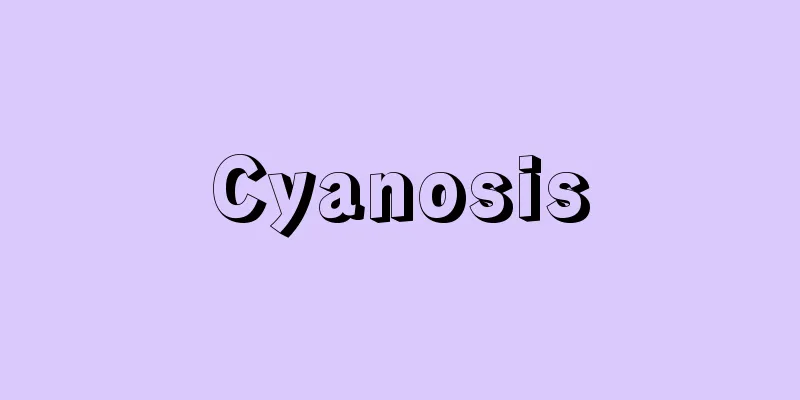Cyanosis

|
Concept Cyanosis is a bluish discoloration (blue-purple) of the skin or mucous membranes caused by an increase in reduced or abnormal hemoglobin in the capillary venous plexus. It is most commonly seen on the ears, lips, nail beds, and malar ridges. However, the appearance of cyanosis can be influenced by a variety of factors, making it difficult to accurately diagnose the presence and severity of cyanosis. For example, in patients with dark skin, it is more important to examine the oral mucosa and conjunctiva than to judge by skin tone. The severity of cyanosis is proportional to the absolute amount of reduced hemoglobin and is therefore influenced by the total hemoglobin amount. Therefore, cyanosis is more likely to be seen in patients with marked polycythemia, and conversely, cyanosis is less likely to be seen in patients with severe anemia, even if there is marked hypoxemia. The presence of jaundice can also make it difficult to detect the presence of cyanosis. Pathophysiology: Cyanosis of the skin is generally observed when the capillary deoxygenated hemoglobin level is 4-5 g/dL or higher. This increase in capillary deoxygenated hemoglobin is caused by hypoxia in the arterial blood or by vascular constriction causing a slowdown in peripheral blood flow, resulting in excessive removal of oxygen from the capillaries. Cyanosis is broadly classified into two pathophysiological types: central and peripheral. Central cyanosis occurs when the increase in reduced hemoglobin is due to a decrease in arterial blood oxygen saturation caused by hypoxemia, and is mainly caused by cardiac and respiratory diseases. Cyanosis caused by cardiac disease is caused by a decrease in arterial blood oxygen saturation due to a pathological condition in which blood flow in the systemic venous system is shunted to the arterial system (right-to-left shunt). Causes of cyanosis caused by respiratory disease include an imbalance between pulmonary ventilation and blood flow (obstructive pulmonary disease), impaired oxygen diffusion capacity (restrictive pulmonary disease), and impaired gas exchange due to hypoventilation (neuromuscular disease). Cyanosis can also occur in methemoglobinemia and sulfhemoglobinemia, which are caused by a decrease in oxygen conjugation capacity due to hemoglobin abnormalities. Peripheral cyanosis does not show a decrease in arterial blood oxygen saturation, but occurs when excessive oxygen is removed while flowing through the capillaries due to a decrease in peripheral blood flow. Causes include exposure to cold or cold water, shock, congestive heart failure, and peripheral vascular disease such as arteriosclerosis. Differential diagnosis (Table 2-25-2) Central cyanosis can be seen in both the skin and mucous membranes. However, in patients with patent ductus arteriosus and a right-to-left shunt, dissociative cyanosis (cyanosis occurs in the lower limbs but not the upper limbs) can be seen. In patients with central cyanosis, both arterial blood oxygen pressure and oxygen saturation are decreased. Improvement in oxygen saturation with inhalation of 100% oxygen is not seen in patients with cyanotic heart disease, but is seen in patients with pulmonary disease or ventilation disorders. If the cause of cyanosis due to cardiac or pulmonary disease is unclear, the presence of abnormal hemoglobin must be considered. Peripheral cyanosis appears on the skin of the fingertips and ears, but is often not seen on mucous membranes such as the oral mucosa and bulbar conjunctiva. In addition, arterial blood oxygen tension and oxygen saturation are normal, making it relatively easy to differentiate from central cyanosis. Peripheral cyanosis is affected by the surrounding temperature, and generally improves with warmth. Cardiogenic shock accompanied by pulmonary edema requires caution as it is a mixture of the two types. [Shigemasa Chiaki] ■ References Braunwald E: Examination of the patient. In: Heart Disease (Braunwald E ed), pp6-7, WB Saunders, Philadelphia, 1988. Fishman AP: Approach to the patient with respiratory symptoms: cyanosis and clubbing. In: Fishman's Pulmonary Diseases and Disorders, 3rd ed (Fishman AP, et al eds), pp382-383, WB Saunders, Philadelphia, 1998. Causes of cyanosis Table 2-25-2 Source : Internal Medicine, 10th Edition About Internal Medicine, 10th Edition Information |
|
概念 チアノーゼは皮膚または粘膜が青みを帯びた変色(青紫色)をきたした状態であり,毛細血管の静脈叢の還元ヘモグロビンあるいは異常ヘモグロビンの増加が原因である.耳介,口唇,爪床,頬隆起部などに最も出現しやすい.しかし,チアノーゼ発現は諸種の要因によって影響を受ける可能性があり,チアノーゼの存在やその程度を正確に診断することが困難なことがある.たとえば肌の色が黒い患者は皮膚の色調で判断するよりも口腔粘膜や結膜の観察の方が重要となる.チアノーゼの程度は還元ヘモグロビンの絶対量に比例することから全ヘモグロビン量によって影響されるので,著明な赤血球増加症ではチアノーゼはみられやすくなるし,逆に重症の貧血では著しい低酸素血症があったとしてもチアノーゼは現れにくくなる.また黄疸の存在はチアノーゼの存在をわかりにくくする. 病態生理 一般に皮膚でチアノーゼが認められるのは毛細血管の還元ヘモグロビン量が4~5 g/dL以上になった場合である.毛細血管におけるこの還元ヘモグロビン量の増加は,動脈血の低酸素,または血管が収縮し末梢の血流が減速したために毛細血管から過剰に酸素が除去されることにより生じる. チアノーゼは病態生理学的に大きく中枢型と末梢型の2つに分類される.中枢型チアノーゼは,還元ヘモグロビン増加の原因が低酸素血症による動脈血酸素飽和度の低下に由来する場合で,おもに心疾患と呼吸器疾患に生じる.心疾患に由来するチアノーゼの要因は,体静脈の血流が動脈系にシャントする病態(右左シャント)による動脈血酸素飽和度の低下である.呼吸器疾患に由来するチアノーゼの原因は,肺換気と血流の不均衡(閉塞性肺疾患),酸素拡散能の障害(拘束性肺疾患),低換気によるガス交換障害(神経筋肉疾患)などがあげられる.チアノーゼはメトヘモグロビン血症やスルフヘモグロビン血症でも起こりうるが,これらはヘモグロビン異常による酸素抱合能低下による. 末梢型チアノーゼは動脈血酸素飽和度の低下を認めないが,末梢血流の減少により,毛細血管を流れる間に酸素が過剰に除去されることによって発生する.原因としては,寒冷または冷水暴露,ショック,うっ血性心不全,動脈硬化症などの末梢血管疾患によって起こる. 鑑別診断(表2-25-2) 中枢型チアノーゼは皮膚・粘膜いずれにおいても認められる.しかし動脈管開存症では右左シャントがあると解離性チアノーゼ(下肢でチアノーゼが発症し,上肢ではみられない)が認められる.中枢型チアノーゼでは動脈血酸素分圧と酸素飽和度はともに低下している.100%酸素吸入による酸素飽和度改善はチアノーゼ性心疾患ではみられないが,肺疾患や換気障害では認められる.心・肺疾患によるチアノーゼの原因がはっきりしなければ異常ヘモグロビンの存在を考慮する必要がある. 末梢型チアノーゼは指尖,耳介などの皮膚には出現するが,口腔粘膜や眼球結膜などの粘膜には認めないことが多い.また動脈血酸素分圧や酸素飽和度は正常であり,中枢型チアノーゼと鑑別は比較的容易である.末梢型チアノーゼは周囲の温度によって影響され,保温によって一般的には改善する.肺水腫を伴う心原性ショックは2つの型が混合した所見となるので注意を要する.[重政千秋] ■文献 Braunwald E: Examination of the patient. In: Heart Disease (Braunwald E ed), pp6-7, WB Saunders, Philadelphia, 1988. Fishman AP: Approach to the patient with respiratory symptoms: cyanosis and clubbing. In: Fishman's Pulmonary Diseases and Disorders, 3rd ed (Fishman AP, et al eds), pp382-383, WB Saunders, Philadelphia, 1998. チアノーゼの原因疾患"> 表2-25-2 出典 内科学 第10版内科学 第10版について 情報 |
Recommend
Levi
French orientalist. He studied Sanskrit at the Uni...
Santeria (English spelling)
…Religion is permitted as long as it does not vio...
Sake Unjo - Sake Unjo
A sake brewing tax was imposed on the sake brewing...
Palau - Republic of Palau (English spelling)
An island nation located 820 km east of the Phili...
San-jie-he (three bonds)
A method in China where representatives from three...
Asahi Lawsuit - Asahi Lawsuit
Shigeru Asahi (1913-1964), who was a resident of ...
Khitan ancient land
...The climate was generally warm, with the Angar...
Hirano Shrine
It is located in Hiranomiya Honmachi, Kita Ward, ...
Utraquist - Utraquist
…reigned 1458-71. Czech prince who led the modera...
Ca' d'oro (English spelling)
A typical Venetian Gothic mansion facing the Grand...
King Daiitoku
One of the Five Great Wisdom Kings. Placed in the...
Arsaces I (English spelling)
… [history] The founding of the Parthian state to...
Ḥelwān (English spelling)
A city in northern Egypt, south of Cairo. Also cal...
Feverwort
...It is distributed in Nagano Prefecture, northe...
Sonnino - Sonny's (English spelling) Giorgio Sidney Sonnino
Italian politician and baron. After serving as a ...









